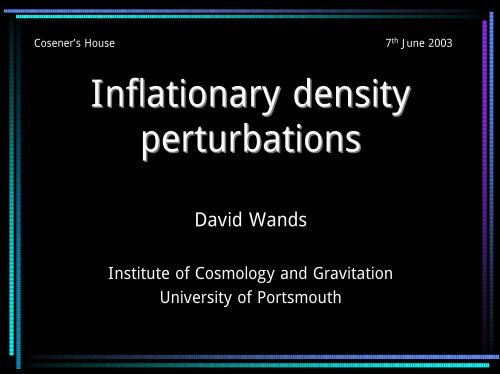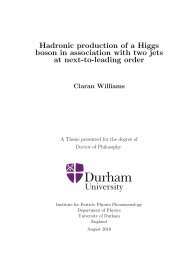Inflationary density perturbations - Institute for Particle Physics ...
Inflationary density perturbations - Institute for Particle Physics ...
Inflationary density perturbations - Institute for Particle Physics ...
- No tags were found...
You also want an ePaper? Increase the reach of your titles
YUMPU automatically turns print PDFs into web optimized ePapers that Google loves.
outline! some motivation! Primordial Density Perturbation(and conserved quantities on large scales)! constraints on single-field models! predictions from multi-field models! conclusions
Cosmological inflation: Starobinsky (1980)Guth (1981)• period of accelerated expansionin the very early universe• requires negative pressuree.g.self-interacting scalar fieldV(φ)• speculative and uncertain physicsφ• just the kind of peculiar cosmologicalbehaviour we observe today
Motivation:inflation in very early universe testable throughprimordial perturbation spectra! radiation/matter <strong>density</strong> <strong>perturbations</strong>! + gravitational waves (we hope)gravitationalinstabilitynew observational data offers precision tests of cosmologicalparameters and the Primordial Density Perturbation
Primordial Density Perturbatione.g., epoch of primordial nucleosynthesiscosmic fluid consists of– photons, γ, neutrinos, ν, baryons, B, cold dark matter, CDM,(+quintessence?)! total <strong>density</strong> perturbation, orcurvature perturbationR ≈δρδρ/ρ! relative <strong>density</strong> <strong>perturbations</strong>, orisocurvature pertbns S i =δ(n i /n γ )/(n i /n γ )! large-angle CMB: (∆T/T) lss ≈ [ R - 2S m ] / 5
Conserved cosmological <strong>perturbations</strong>Lyth & Wands in preparationtimet 2t 1ABFor every quantity, x, that obeys a local conservation equationdxdNspace= y( x), e.g.& ρ = −3Hρwhere dN = Hdt is the locally-defined expansion along comoving worldlinesthere is a conserved perturbationwhere perturbation δ x = x A -x Bis a evaluated on hypersurfacesseparated by uni<strong>for</strong>m expansion ∆N=∆lnamζ ≡ δN=xmδ xy(x)
where do these <strong>perturbations</strong> come from?
<strong>perturbations</strong> in an FRW universe:waveequation2δ & φ+ 3Hδφ&− ∇ δφ =Characteristic timescales <strong>for</strong> comoving wavemode k– oscillation period/wavelength a / k– Hubble damping time-scale H -1• small-scales k > aH under-damped oscillator• large-scales k < aH over-damped oscillator (“frozen-in”)0vacuumcomoving Hubble lengthH -1 / afrozen-inoscillatescomovingwavelength, k -1con<strong>for</strong>mal timeinflationaccelerated expansion(or contraction)radiation or matter eradecelerated expansion
Wilkinson Microwave Anisotropy Probe February 2003coherent oscillationsin photon-baryon plasmafrom primordial <strong>density</strong><strong>perturbations</strong>on super-horizon scales
Vacuum fluctuationsV(φ)Hawking ’82, Starobinsky ’82, Guth & Pi ‘82• small-scale/underdamped zero-point fluctuations• large-scale/overdamped <strong>perturbations</strong> in growing modelinear evolution ⇒ Gaussian random field2δφ≈4πk3δφ2kk = aH3(2π) 2πfluctuations of any light fields (m M PlNiemeyer; Brandenberger & Martin (2000)effect likely to be small <strong>for</strong> H
Inflaton -> matter <strong>perturbations</strong>R =<strong>for</strong> adiabatic <strong>perturbations</strong> on super-horizon scales R & = 0during inflationscalar field fluctuation, δφscalar curvatureon uni<strong>for</strong>m-fieldhypersurfacesHδσ& σduring matter+radiation era<strong>density</strong> perturbation, δρtimescalar curvatureon uni<strong>for</strong>m-<strong>density</strong>hypersurfacesR =Hδρ& ρζ ζ = ζ = ζ = ζ=cdm( ) necessarily adiabatic primordial <strong>perturbations</strong> γ B νσ
Inflaton scenario:high energy / not-so-slow roll1. large field ( ∆ϕ < M Pl )e.g. chaotic inflationsee, e.g., Lyth & RiottoKinney, Melchiorri & Riotto (2001)0
can be distinguished by observations• slow time-dependence during inflation-> weak scale-dependence of spectran = 1 − 6ε + 2η• tensor/scalar ratio suppressed at low energies/slow-rollT2R2= 16ε
WMAP constraints (I)• Microwave background only (WMAPext)Peiris et al (2003)r< 1.28Harrison-Zel’dovichspectralindexn R≈ 1 − 6ε + 2ηn → 1, r → 0
WMAP constraints (II)• Microwave background + 2dF + Ly-alphaPeiris et al (2003)r< 1.28spectralindexn R≈ 1 − 6ε + 2η
WMAP constraints (III)• Microwave background + 2dF + Ly-alphaPeiris et al (2003)dn R/dln k= −0.055+ 0.028−0.029n R=1 .13±0.08r< 1.28
scale-dependent tilt?dlnk≈ −dn R2( 3ε− η)2ξ −8ε2• third slow-roll parameterξ ≡VV4M Pl , φ264πV, φφφ– involving four derivatives of the potential, not two– the beginning of the end <strong>for</strong> slow-roll?• inflaton effective mass is not constantdη≈ − 2 ξ + 2εηdNslow-roll inflation could be just a passing phase!
digging deeper:• additional fields may play an important role• initial state• ending inflation• enhancing inflationnew inflationhybrid inflationassisted inflationwarm inflationbrane-world inflation• producing <strong>density</strong> <strong>perturbations</strong>• may yield additional in<strong>for</strong>mation• non-gaussianity• isocurvature (non-adiabatic) modes
Inflation -> primordial <strong>perturbations</strong> (II)scalar field fluctuationstwo fields (σ,χ)curvature of uni<strong>for</strong>m-field slicesR =*isocurvatureS =*Hδσ& σHδχ& σ⎛⎜⎝RS⎞⎟⎠⎛1=⎜primordial⎝0k
examples:• field dynamics during inflationPolarski & Starobinsky; Sasaki & Stewart; Garcia-Bellido &Wands; Steinhardt & Mukhanov; Adams, Ross & Sarkar;Langlois… (1996+)• variable couplings during/after reheatingDvali, Gruzinov & Zaldariaga; Kofman (2003)• late-decaying scalar : the curvaton scenarioEnqvist & Sloth; Lyth & Wands; Moroi & Takahashi (2001+)
curvaton scenario:Lyth & Wands, Moroi & Takahashi, Enqvist & Sloth(2002)assume negligible curvature perturbation during inflation 2R *= 0light during inflation, hence acquires isocurvature spectrumlate-decay, hence energy <strong>density</strong> non-negligible at decaylarge-scale <strong>density</strong> perturbationgenerated entirely bynon-adiabatic modesafter inflationR22= T RSS2*≈ΩTRS≈ Ω χ , decay2χ , decay2S *≈δρρχχ( δρχ χ/ ρ )2•negligible gravitational waves•100%correlated residual isocurvature modes•detectable non-Gaussianity if Ω χ,decay
primordial isocurvature <strong>perturbations</strong> from curvaton?Moroi & Takahashi; Lyth, Ungarelli & Wands ‘03• cdm, neutrinos, baryon asymmetry all created after curvaton decaysζ( ζγ= ζν= ζ = ζ ) ≈ Ωχ, decayζχ=cdm B⇒ S = 0i• cdm/baryon asymmetry created at high energies be<strong>for</strong>e curvaton decayζ = ζγ≈ Ωχ, decayζχ, ζm=0⇒S m= −3ζ• 100% correlation between curvature and “residual” isocurvature mode• naturally of same magnitude• neutrino asymmetry (ξ
Observational constraintsGordon & Lewis, astro-ph/0212248v2using CMB + 2dF + HST + BBNisocurvature / curvature ratioB = S B / ζpre-WMAP95%c.f. Peiris et alf iso = S cdm /ζ≈ 0.1 Band marginalised overcorrelation angle-> f iso < 0.33post-WMAP
isocurvature <strong>perturbations</strong> from curvaton (II)• cdm/baryon asymmetry created by curvaton decayζ = ζ= ζγ≈ Ωχ,decayζχ, ζmχLyth, Ungarelli & Wands ’02Gupta, Malik & Wands in preparation⇒S m=( )χ , decay− Ω ζ = 3⎜ζ3 1χ , decayχ⎛1− Ω⎜⎝ Ωχ , decay⎟ ⎞⎠• curvature and isocuravture <strong>perturbations</strong> naturally of same magnitude• relative magnitude related to non-Gaussianity
non-Gaussianitysimplest kind of non-Gaussianity:Komatsu & Spergel (2001)Wang & Kamiokowski (2000)recall that <strong>for</strong> curvatoncorresponds toδρρ≈δρΩχ ,decayδρρδρ≈ρsignificant constraints on f NL from WMAP f NL < 134χχ⎛≈⎞⎛⎜⎝Ωδ1ρ⎞⎟ +ρ ⎠χ ,decayf NL2⎛ δ1ρ⎞⎜ ⎟⎝ ρ ⎠⎛⎜ δχ ⎛ δχ ⎞+ ⎜ ⎟⎜ χ⎝ ⎝ χ ⎠1ρδχ1≈ Ωχ,decay⎜⎟ , fNL≈χΩχ,decay⎝⎠2⎞⎟⎟⎠Lyth, Ungarelli & Wands ‘02hence Ω χ,decay > 0.01 and 10 -5 < δχ/χ < 10 -3
observable parameters• inflaton regime– curvature & tensor <strong>perturbations</strong>– n s & tensor/scalar ratio = n t• curvaton regime– curvature + isocurvature <strong>perturbations</strong>– n s = n iso & isocurvature/curvature ratio• intermediate regime– n s , n iso , n corr , n t , tensor/scalar, iso/curvature, correlationWands, Bartolo, Matarrese & Riotto, ‘02
Conclusions:1. Observations of tilt of <strong>density</strong> <strong>perturbations</strong>(n≠1) and gravitational waves (ε>0) candistinguish between slow-roll models2. Isocurvature <strong>perturbations</strong> and/or non-Gaussianity may provide valuable info3. Non-adiabatic <strong>perturbations</strong> in multi-field modelsare an additional source of curvature <strong>perturbations</strong>on large scales4. Consistency relations remain an important testin multi-field models - can falsify slow-roll inflation5. More precise data allows/requires us to studymore detailed models!
















